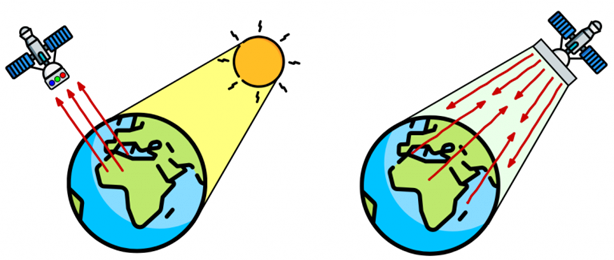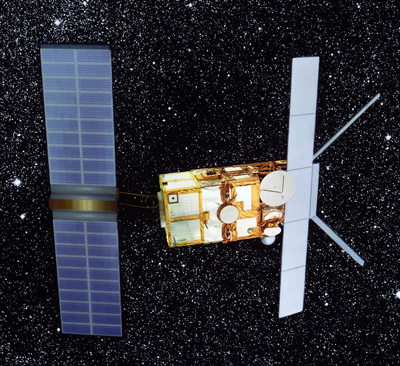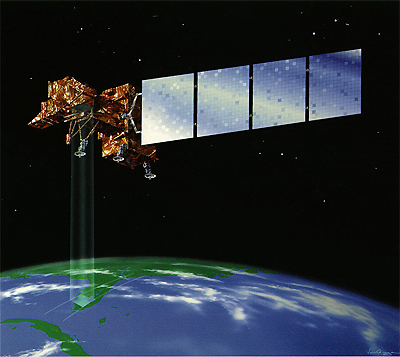2. Satellites
Active and passive satellite sensors
Another possibility to distinguish between earth observation satellites is to compare the sensors used. In general, there are passive sensors which measure the reflected sunlight or thermal radiation, and active sensors which make use of their own source of radiation.
Active sensors (for example Radar and laser scanners) emit artificial radiation to monitor the earth surface or atmospheric features. Radars are imaging instruments while radar altimeters and scatterometers are non imaging. Radar is the abbreviation for Radio Detection and Ranging, a method for the detection and ranging of earth surface features. Radar satellites use short pulses of electromagnetic radiation in the microwave spectral range, therefore they do not depend on daylight and are hardly affected by clouds, dust, fog, wind and bad weather conditions. They measure the radar pulses reflected from the ground, analyse the signal intensity in order to retrieve information on the structure of the earth surface, and detect the elapsed time between pulse emission and return. Results can be used to measure distances. Depending on the satellite mission, different operations and procedures are used to process the signals into viable information.
Advantages and disadvantages of active sensors:
| Advantages | Disadvantages |
| Weather independent: artificial microwave radiation can penetrate clouds, light rain and snow. | The pulse power is mostly low and can be influenced or interfered by other radiation sources. |
| Sunlight independent: can be operated day and night. | |
| Radar penetrates vegetation and soil: can gain information about surface layer from mm to m depth. | Radar signals contain no spectral characteristics. |
| Can give information about moisture content of soil layer. | Complicated analysis, cost-intensive. |
| Various applications: oceanography, hydrology, geology, glaciology, agriculture and forestry services. |
ERS-2 is an example of an European satellite and was launched in 1995 from French Kourou with an ARIANE launching vehicle. ERS-2 is revolving on a polar orbit at an altitude of 785 km with a speed of 7.5 km per second, monitoring a band 100 km wide.

Source: Paititi Research
Passive sensors detect sunlight radiation reflected from the earth and thermal radiation in the visible and infrared of the electromagnetic spectrum. They do not emit their own radiation, but receive natural light and thermal radiation from the earth's surface. Most passive sensors make use of a scanner for imaging, e.g. LANDSAT. Equiped with spectrometers they measure signals at several spectral bands simultaneously, resulting in so-called multispectral images which allow numerous interpretations, see Understanding Spectra from the Earth.


